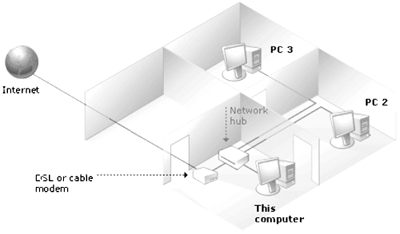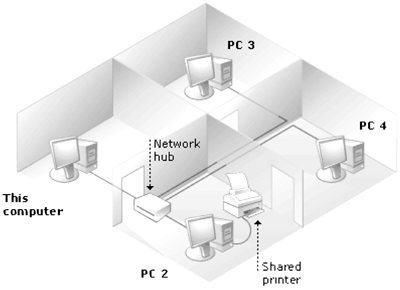Understanding Network Services
| Windows is a secure, reliable network operating system that allows people using many different computers to share resources, such as programs, files, folders, printers, and an Internet connection. A single computer on the network, called a server , can be designated to store these resources. Other computers on the network, called clients or workstations , can access the resources on the server instead of having to store them. You can share resources using two or more client computers, or you can designate one computer to serve specifically as the server. If the workstation computers are close together in a single building or group of buildings , the network is called a local area network ( LAN ) . If the workstation computers are spread out in multiple buildings or throughout the entire country using dial-up or wireless connections, the network is called a wide area network ( WAN ) . To set up a network with multiple computers, you need to install a network adapter for each computer on your network and connect each computer to a network hub using network cable or wireless technology. Network adapters are usually hardware cards, called network interface cards , or NICs , inserted in a slot, or USB (Universal Serial Bus) , port in the back of your computer that connects it to the network. A network hub is a hardware device that connects multiple computers at a central location. When data arrives at one port of the network hub, it is copied to the other ports so that all connected network devices see the data. If you have two LANs or two sections of the same LAN on different floors of the same building with different network adapter types, you can connect them together with a hardware device called a bridge . If you have any number of LANs, you can connect them together with a hardware device called a router . If you want to share a printer or Internet connection with the computers on a network, you simply connect the printer or modem to the server, a computer on the network, or directly to a network hub, router, or bridge. Share central resources through client/server networkingWindows offers a network configuration called client/server networking . Under this arrangement, a single computer is designated as a server, allowing access to resources for any qualified user . Client/server networking provides all users on a network a central location for accessing shared files. In a client/server network, individual computers are often grouped into domains. A domain is a collection of computers that the person managing the network creates to group together computers used for the same tasks and to simplify the set up and maintenance of the network. The network administrator defines the domains that exist on the network and controls access to computers within those domains. Domains are available only with the Professional edition. Share resources through peer-to-peer networkingWindows also offers a network configuration called peer-to-peer networking . Peer-to-peer networking enables two or more computers to link together without designating a central server. In a peer-to-peer network, individual computers are often organized into workgroups. A workgroup is a group of computers that perform common tasks or belong to users who share common duties and interests. In this configuration, any computer user can access resources stored on any other computer, as long as those resources are available for sharing. Peer-to-peer networking allows individual computer users to share files and other resources, such as a printer, with other users on the network without having to access a server. Workgroups are available on all Windows XP computers. Share resources through network connectionsWindows provides connectivity between your computer and a network, another computer, or the Internet using Network Connections . Whether you are physically connected using a direct cable or connected remotely using a dial-up or cable modem, you can connect securely to a network over the Internet using a Virtual Private Network ( VPN ) connection or set up your computer to let other computers connect to yours using an incoming network connection . VPN and incoming network connection are examples of WANs. Share designated files and folders on your computer with other network usersWindows provides support for security, so even though your computer is connected to a network, you can designate which resources on your computer you want to share with others. Before network users can use any resources on your computer, they must be granted the required permission. |
EAN: 2147483647
Pages: 391

